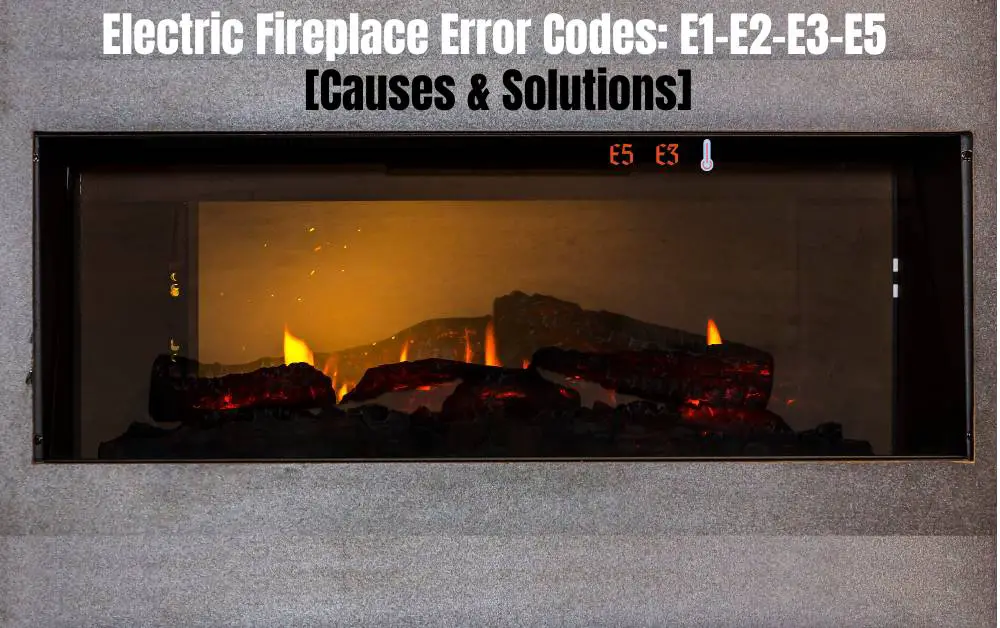Electric fireplaces provide the cozy ambiance of a traditional fireplace without the hassle of wood or gas. However, when your electric fireplace starts making unusual or excessive noise, it can quickly turn from a comforting feature into an annoying distraction. If you’re wondering “why is my electric fireplace so loud,” you’re not alone.
Many homeowners experience this issue, which can be caused by everything from loose components and debris in the fan to normal operational sounds that simply seem louder than expected.
This comprehensive guide will help you identify the source of the noise, troubleshoot common problems, and determine when it’s time to call a professional for repair.
Key Takeaways
- Most electric fireplace noises are caused by issues with the fan, heater element, or loose components
- Regular maintenance can prevent many common noise problems
- Some noise is normal during operation, but loud or unusual sounds often indicate a problem
- Simple troubleshooting steps can resolve many minor issues without professional help
- Safety should always be your priority when diagnosing or fixing a noisy electric fireplace
Common Causes of Loud Electric Fireplaces
Electric fireplaces can produce various types of noise, and identifying the specific sound is the first step toward solving the problem. Here are the most common reasons why your electric fireplace might be making excessive noise:
Fan and Blower Issues
The fan or blower is one of the most common sources of noise in electric fireplaces. These components are responsible for distributing the heat generated by the heating elements throughout the room. When functioning properly, they should produce a gentle hum or whooshing sound. However, several issues can cause the fan to become unusually loud:
- Debris accumulation: Dust, pet hair, and other debris can accumulate on the fan blades, causing imbalance and noise. This is particularly common in fireplaces that haven’t been cleaned regularly.
- Worn bearings: Over time, the bearings in the fan motor can wear out, causing grinding, squealing, or rattling noises.
- Loose components: Screws or other fasteners holding the fan in place may become loose, allowing the fan to vibrate excessively against other components.
- Faulty motor: In some cases, the motor itself may be failing, producing humming or buzzing sounds that get progressively worse.
According to the Electrical Safety Foundation International, regular maintenance of electric appliances, including fireplaces, can help prevent many common issues that lead to noise or malfunction.
Heater Element Problems
The heating element in your electric fireplace is another potential source of noise. Common heater-related issues include:
- Expansion and contraction: As the heating element warms up and cools down, it naturally expands and contracts, which can produce clicking or popping sounds. While some of this noise is normal, excessive popping may indicate a problem.
- Loose heating elements: If the heating element isn’t properly secured, it may vibrate or rattle when the fireplace is operating.
- Faulty heating element: A failing heating element may produce buzzing, humming, or crackling sounds.
The U.S. Consumer Product Safety Commission recommends that homeowners regularly inspect their electric appliances for signs of wear or damage to prevent potential hazards.
Loose Components and Vibrations
Electric fireplaces contain numerous components that can become loose over time, especially if the unit is moved frequently. Loose parts can cause a variety of noises, including:
- Rattling: Often caused by loose screws, panels, or internal components.
- Vibrating: May occur when panels or other parts aren’t properly secured.
- Ticking or clicking: Can result from expansion and contraction of materials or loose electrical connections.
A comprehensive guide from This Old House suggests that regular tightening of components can prevent many common noise issues in home appliances.
Normal Operational Sounds
It’s important to recognize that some noise is normal during the operation of an electric fireplace. These sounds include:
- Gentle humming: Typically from the fan motor or electrical components.
- Soft whooshing: The sound of air being moved by the blower.
- Occasional clicking: Usually from the heating element as it expands and contracts.
These normal operational sounds should be relatively quiet and consistent. If the noise is loud, irregular, or has recently changed in character, it likely indicates a problem that needs attention.
Diagnosing the Source of the Noise
Before attempting to fix your noisy electric fireplace, it’s important to accurately diagnose the source of the problem. Here’s a step-by-step approach to identifying what’s causing the noise:
Step 1: Listen Carefully
The type of noise can often indicate its source. Here’s a table to help you match sounds to potential causes:
| Sound Type | Possible Cause | Likelihood |
|---|---|---|
| Rattling | Loose components, debris in fan | High |
| Grinding | Worn fan bearings, foreign objects | Medium |
| Humming/Buzzing | Electrical issues, faulty motor | Medium |
| Clicking/Popping | Heating element expansion, loose connections | High |
| Squealing | Worn fan bearings, belt issues (if applicable) | Low |
Step 2: Isolate the Sound
Try to determine exactly where the noise is coming from:
- Turn off the fireplace and wait for it to cool completely.
- Turn it back on and listen carefully as it starts up.
- Note when the noise begins – immediately upon startup, only when the heater is on, or continuously.
Step 3: Observe Patterns
Pay attention to any patterns in the noise:
- Does it get louder over time?
- Is it constant or intermittent?
- Does it change when you adjust settings?
Step 4: Visual Inspection
After turning off and unplugging the fireplace, perform a visual inspection:
- Remove the front panel or grill if possible (consult your owner’s manual).
- Look for any obvious signs of loose components, debris, or damage.
- Check for any foreign objects that may have fallen into the unit.
Consumer Reports emphasizes the importance of following manufacturer instructions when inspecting or repairing electric appliances to ensure safety and prevent voiding warranties.
Troubleshooting and Fixing a Noisy Electric Fireplace
Once you’ve identified the likely source of the noise, you can attempt to fix the problem. Here are some troubleshooting steps for common issues:
Cleaning the Fan and Blower
A dirty fan is one of the most common causes of noise in electric fireplaces. Here’s how to clean it:
- Turn off and unplug the fireplace. Wait for it to cool completely.
- Remove the front panel or grill according to the manufacturer’s instructions.
- Locate the fan/blower assembly (usually at the bottom or back of the unit).
- Use a soft brush or compressed air to gently remove dust and debris from the fan blades.
- Vacuum the area around the fan to remove any loose particles.
- Replace the front panel and plug the fireplace back in.
Note: If you’re not comfortable doing this yourself, or if your fireplace is still under warranty, contact a professional or the manufacturer for service.
Tightening Loose Components
Loose parts can cause a variety of noises. Here’s how to address this issue:
- Turn off and unplug the fireplace. Let it cool completely.
- Using a screwdriver, check all visible screws and fasteners to ensure they’re tight.
- Gently shake the unit (if it’s not built-in) to listen for any rattling that might indicate loose internal components.
- If you suspect internal components are loose, you may need to remove additional panels to access them. Consult your owner’s manual for instructions.
- Replace any panels and plug the fireplace back in.
Addressing Heater Element Noises
If the noise seems to be coming from the heating element:
- Turn off and unplug the fireplace. Let it cool completely.
- Check if the heating element is visibly loose or damaged. Do not touch it directly.
- If you see any obvious issues, contact a professional for repair. Heating elements can be dangerous to work with if you’re not experienced.
- If the element appears fine, the noise might be normal expansion and contraction. Monitor it to see if it gets worse over time.
When to Call a Professional
While many minor issues can be resolved with simple troubleshooting, some situations require professional help:
- If you hear grinding or metal-on-metal sounds
- If you smell burning or see smoke
- If the fireplace is making electrical buzzing or humming sounds
- If you’ve tried basic troubleshooting and the noise persists
- If the fireplace is still under warranty (DIY repairs may void the warranty)
The International Association of Certified Home Inspectors recommends that homeowners seek professional assistance for any electrical appliance issues that seem beyond their expertise to ensure safety and proper repair.
Preventive Maintenance for Electric Fireplaces
Regular maintenance can prevent many common noise problems and extend the life of your electric fireplace. Here’s a recommended maintenance schedule:
Monthly Maintenance
- Dust the exterior surfaces with a soft, dry cloth.
- Check for any unusual noises during operation.
- Ensure the area around the fireplace is clear of flammable objects.
Quarterly Maintenance
- Vacuum the air intake and exhaust areas to remove dust and debris.
- Check that all cords and connections are secure.
- Inspect the unit for any visible damage or wear.
Annual Maintenance
- Perform a thorough cleaning of the interior components, including the fan and blower.
- Check all electrical connections and components for signs of wear or damage.
- Consider having a professional inspect the unit, especially if it’s used frequently.
Long-Term Care Tips
- Keep the owner’s manual in a safe place for reference.
- Only use replacement parts recommended by the manufacturer.
- Avoid using the fireplace if it’s making unusual noises until you can identify and fix the problem.
- Consider registering your fireplace with the manufacturer to receive notifications about any recalls or service bulletins.
FAQs
Is it normal for my electric fireplace to make noise?
Some noise is normal during operation, including gentle humming from the motor and soft whooshing from the blower. However, loud, unusual, or recently changed noises often indicate a problem that needs attention.
Why is my electric fireplace making a rattling noise?
Rattling is commonly caused by loose components, debris in the fan, or unsecured panels. Turn off and unplug the unit, then check for any visible loose parts or debris that might be causing the sound.
Can I fix my noisy electric fireplace myself?
Many minor issues, such as cleaning the fan or tightening loose screws, can be safely done by homeowners. However, for electrical issues, heating element problems, or anything involving disassembly beyond basic panel removal, it’s best to consult a professional.
Final Thoughts
A noisy electric fireplace can be frustrating, but in most cases, the problem can be identified and resolved with proper troubleshooting and maintenance. By understanding the common causes of noise, performing regular maintenance, and knowing when to seek professional help, you can keep your electric fireplace operating quietly and efficiently for years to come.
Remember that safety should always be your priority. If you’re ever unsure about diagnosing or fixing a problem with your electric fireplace, it’s better to consult a professional than to risk injury or further damage to the unit.
With the information provided in this guide, you should now have a better understanding of why your electric fireplace might be making noise and what steps you can take to address the issue. Enjoy the warmth and ambiance of your quiet, properly functioning electric fireplace!
Affiliate Disclosure: Fireplaceadviser.com is a participant in the Amazon Services LLC Associates Program. We may earn a commission when you click on certain links on this site and purchase.

Hello!! I am Jamal Khan. I often fix my home electric heaters and gas stove problems and research the common issues in the heating units to improve my knowledge and expertise. The aim of establishing fireplaceadviser.com is to share my expertise and knowledge with my audience.












